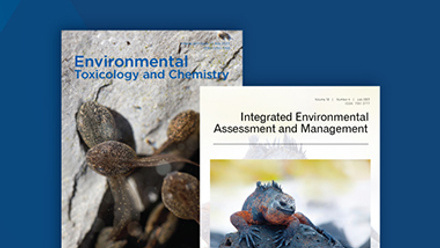Advancing the Science of Behavioral Ecotoxicology and the Use of Behavioral Endpoints in Ecotoxicity and Environmental Assessments
Michael Bertram, Swedish University of Agricultural Sciences; Camille Flinders, National Council for Air and Stream Improvement; Minna Saaristo, Environment Protection Authority Victoria; Daniel Sullivan, U.S. Environmental Protection Agency
The session titled “Advancing the Use of Behavioral Endpoints and Methods in Assessments of Environmental Contaminants” will take place during the SETAC North America 44th Annual Meeting from 12–16 November in Louisville, Kentucky.
Readers and interested scientists are encouraged to fill out a survey on behavioural ecotoxicology in the protection of human and ecosystem health. Learn more below.
What is the current role of behavioral ecotoxicology in environmental protection? What role could it play in the future?
It has been recognized for decades that chemical pollutants can influence wildlife behavior. Examples of this range widely across pollutant classes and exposed species, from impaired anti-predator behaviors in fish exposed to anxiety-reducing pharmaceuticals to reduced feeding and delayed migration in birds contaminated with neonicotinoid insecticides. Moreover, due to rapid recent technological advances in the software and hardware available to behavioral ecotoxicologists, researchers are continuously discovering more evidence that numerous contaminants adversely affect organismal behaviors even at low, sub-lethal exposure levels. This is cause for concern given that behavior plays a fundamental role in essential biological functions such as mating, obtaining food and avoiding predation, each of which can directly influence the survival and reproductive success of individuals. Because of this direct link with organismal fitness, behavioral responses are indicative of higher-order processes at the population and community levels. Despite this, behavioral endpoints are seldom considered in risk assessment and regulatory toxicology.
It is increasingly becoming accepted that behavior-mediated adverse effects should be considered in environmental regulatory programs. As such, there is an urgent need to develop and standardize methods for evaluating organismal behavior to advance the field of behavioral ecotoxicology and its incorporation into contaminant and environmental assessments. For instance, it is vital to conduct further studies demonstrating that behavioral endpoints are as sensitive as, or more sensitive than, existing standardized toxicity methods. Further, some behavioral ecotoxicity tests show promise in providing faster results compared with traditional endpoints, making them potential candidates for screening tests or continuous biomonitoring. Historically, behavioral testing was time intensive and logistically complex because of, for example, manual scoring of organismal behavior by researchers. However, new technologies like automated tracking systems allow for much faster and more accurate assessment of behavioral effects. In this regard, a recent review provides a thorough overview of the latest advances in behavioral ecotoxicology tools and techniques.
By showcasing research outcomes that demonstrate the value of behavioral endpoints and highlighting the urgent need to establish standardized methods in this rapidly growing field, the aim of this session at SETAC Louisville is to move behavioral ecotoxicology further towards acceptance as a tool in environmental regulation. More specifically, the goal is to enhance the understanding of challenges and opportunities in behavioral ecotoxicology within the regulatory toxicology and risk assessment framework by inviting experts from various fields including behavioral ecology, ecotoxicology, regulatory (eco)toxicology, neurotoxicology, test standardization and risk assessment to showcase their research on approaches ranging from low- to high-tech, encompassing methods and measures evaluating a wide range of behavioral responses.
New research to be presented at the SETAC Louisville meeting
This session will feature a number of highly interesting and timely presentations from researchers within regulatory agencies, academia and industry across the globe, including Sweden, Australia, Canada, Denmark, Singapore, the United Kingdom and the United States. Presentation topics will reflect two key aspects of behavioral ecotoxicological endpoints in risk assessment and their adoption into a regulatory framework: (i) the development and evaluation of test methods and measured behavioral responses and (ii) the current status and knowledge gaps regarding behavioral endpoints and their relationship to currently used regulatory lethal and sublethal endpoints. Original research describing test approaches and behavioral effects evaluations reflect a wide range of marine and freshwater taxa (amphipods, fish, earthworms, midges, springtails and sea anemones) and species (Folsomia candida, Pimephales promelas, Danio rerio, Chironomus dilutus, Hyalella azteca, Lumbriculus variegatus and Echinogammarus marinus) and different toxicant categories (trace metals, phthalates, pesticides and plastic additives and leachates). Sediment and water assays measured avoidance or selection, movement metrics (e.g., distance, speed), mating behavior, sperm count and chemosensory response in the context of various test conditions (e.g., presence or absence of soil, light) and acclimation procedures.
In addition to original test methods and exposure response research, several session presentations will describe the status of the use of behavioral endpoints in ecotoxicology and risk assessment, gaps in current knowledge necessary to advance the use of behavioral endpoints in regulatory frameworks, and the relationship between currently used lethal and sublethal endpoints in regulation with behavioral endpoints. Specifically, these presentations will describe challenges in using behavioral ecotoxicity endpoints in the context of existing risk assessment and regulatory structures, and propose guidelines, tools and methodologies that consider and incorporate the unique requirements and challenges of behavioral assessment and endpoints. Importantly, the relationships between behavioral and traditional responses will be described, and key outstanding questions, the context for addressing them, as well as strategies for using behavioral measures in toxicity assessments will be presented.
Surveying perceptions about the quality and utility of behavioral ecotoxicology to protect human and ecosystem health
As described above, behavioral data are seldom employed in the regulation of chemical contaminants and are rarely utilized in risk assessment. As a result, a group of behavioral ecotoxicology experts led by Alex Ford, University of Portsmouth, developed a survey to assess the broader scientific community regarding their perceptions of behavioral endpoints and the potential obstacles that they perceive may be associated with incorporating behavioral endpoints into ecotoxicology, environmental regulation and risk assessments. Findings from this study will be presented at the SETAC Europe 34th Annual Meeting next May in Seville, Spain.
The survey comprises two sections, the first of which includes questions about the participants, while the second delves into perceptions regarding the quality and efficacy of behavioral ecotoxicology in safeguarding human and ecosystem health. The survey encompasses 12 questions in total and is designed to take approximately five minutes to complete. Your honest and detailed responses to the additional free-text questions, if you choose to elaborate, will greatly aid the research team in understanding your viewpoints. The survey will be open for participation from July to December 2023 and aims to recruit scientists engaged in environmental toxicology, risk assessment and behavioral sciences. Prior experience in the field of behavioral ecotoxicology is not a requirement for participation.
Authors' contact information: Michael Bertram, [email protected]; Camille Flinders, [email protected]; Minna Saaristo, [email protected]; Daniel Sullivan, [email protected]; Alex Ford, [email protected]






